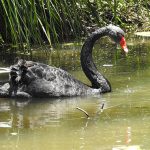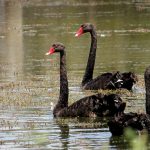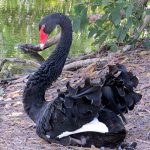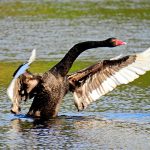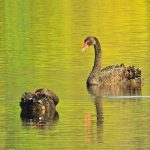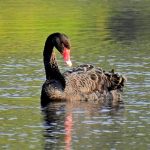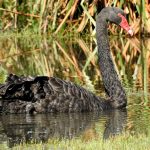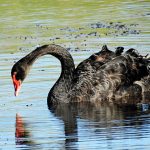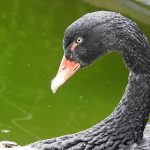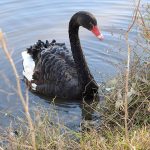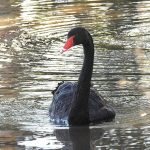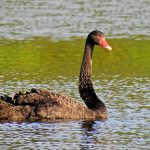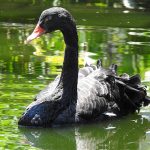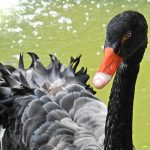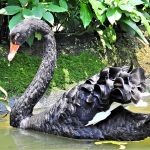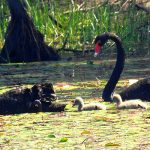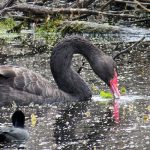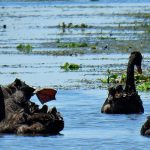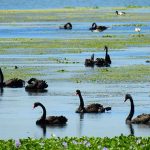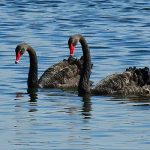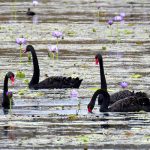BLACK SWAN
The Black Swan – A Living Emblem of Australia
Imagine a serene wetland at dawn. Mist drapes the water’s surface like a delicate veil, and the stillness is broken only by the soft ripples of movement. The mirror-like water reflects the pale blush of the morning sky, and there — gliding with a grace that seems almost otherworldly — is the Black Swan.
Its plumage is a deep, lustrous black that seems to drink in the light, each feather catching the faint shimmer of the day’s first rays. When it takes to the air, the sudden flash of its pure white flight feathers slices through the sky, a moment so striking it feels as though it belongs to the realm of legend.
A Portrait in Colour and Form
The Black Swan’s bill is a marvel in itself — a vivid crimson, glowing like a coal in the half-light, tipped with a precise band of white that stands in perfect contrast to its dark head. Its eyes, also tinged with red, seem to hold a calm, watchful intelligence, while its coal-black legs and webbed feet complete a palette that is both simple and unforgettable.
As one of the largest waterfowl species in the world, the Black Swan commands attention. Its wingspan can stretch between 1.8 and 2.1 metres — as wide as a tall adult human is high — and it can weigh up to 9 kilograms. Yet, despite this size and strength, it moves with the effortless poise of a drifting leaf.
An Australian Native with a Global Footprint
Endemic to Australia, the Black Swan graces wetlands and waterways across the mainland and Tasmania. They are equally at home in the salty embrace of coastal lagoons as they are in the still waters of inland lakes. In the 19th century, their beauty led to introductions in Europe, New Zealand, and other parts of the world. Some escaped captivity and established thriving wild populations — a testament to their adaptability and resourcefulness.
Black Swans share a family lineage with the white swans of Europe, belonging to the Anatidae family. While they have evolved in different environments, they retain similar behaviours: strong pair bonds, shared parental duties, and a preference for life on the water. This divergence in colour and adaptation across continents is a powerful reminder of how the same family tree can branch in vastly different ways.
Life on the Water
In their natural habitat, Black Swans are specialists in aquatic foraging. They feed mainly on submerged vegetation — such as waterweed, pondweed, and algae — dipping their long, elegant necks beneath the water with a gentle sway. Occasionally, they graze on grasses along the shoreline, their quiet presence blending seamlessly into the rhythm of the wetland.
Breeding season, from March to September, brings a transformation in their behaviour. They become devoted nest-builders, weaving large platforms from reeds and sedges, usually anchored among the vegetation at the water’s edge. A clutch of four to eight pale green eggs is laid, and here the Black Swan’s story becomes one of partnership: both male and female take turns incubating the eggs, a shared act of care that continues after the cygnets hatch. The downy young, soft grey and almost weightless, ride safely on the backs of their parents as they learn the ways of the water.
More than a Bird – A Cultural Symbol
The Black Swan is not only a creature of beauty and ecological importance; it has become a cultural emblem in Australia. For the Noongar people of south-western Australia, the Black Swan holds deep spiritual significance, woven into ancestral stories. In modern times, its image appears on the flag and coat of arms of Western Australia, and the term “black swan” has entered global language as a metaphor for the rare and unpredictable.
Outside breeding season, these birds show a sociable side, gathering in large flocks that can number in the thousands. In these gatherings, the water comes alive with movement and sound — the gentle splashes of paddling feet, the low, musical calls that echo over the wetland, and the whirring rush of wings when they take flight together.
A Reminder of What We Stand to Lose
While Black Swans are currently not under serious threat, their dependence on healthy wetland ecosystems means they are vulnerable to habitat loss, pollution, and climate change. Droughts can dry up breeding grounds; degraded waterways can strip them of the aquatic plants they depend on. Protecting wetlands is not just for the swans — these places are lifelines for countless species, from tiny invertebrates to fish, frogs, and migratory birds.
In the story of the Black Swan, we find a narrative of elegance, resilience, and deep cultural meaning. To see one glide across a still lake is to witness a living work of art, a reminder of the rare and beautiful things that exist in the natural world — and of our responsibility to ensure they remain for generations to come.

